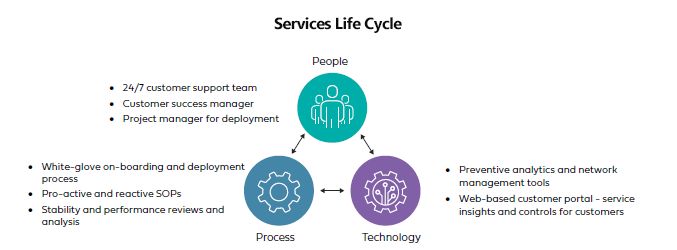The Customer Experience Advantage in a Managed Services WorldThe Customer Experience Advantage in a Managed Services World
Even the best service or product can’t make up for a bad customer experience.
August 20, 2021

By Klaus Schwegler

Klaus Schwegler
In today’s digital economy, having a stellar network and/or security product/managed service that delivers great value isn’t enough to rise above competitors. More than anything, product vendors/service providers need to also offer a superior support structure that drives an incredible customer experience (CX). When determining what that experience is going to be, keep in mind that lasting impressions are driven by what we think/feel when using/consuming a product or service.
When architecting what that customer experience should look like, it helps to put yourself in your customer’s shoes. You can bet that a digital enterprise customer (or potential customer) that’s operating 24/7/365 and offers its customers products or services is investing in its customer experience resources first and foremost. Why would network and security vendors/MSPs be any different?
Blame the Network
When an employee or customer-facing application falters or fails, most people tend to blame the network. But while everyone’s focused on the blame game in the event of a failure, we can’t lose sight of how the service ultimately makes users. From a product/managed services perspective, the users’ experience begins at the produce quote, migrates to onboarding, deployment, management, orchestration, troubleshooting, time to resolution, time to roll out new capabilities and features and communications. This is also referred to as the services life cycle. And how a customer experiences this life cycle is mattering more as the market for network and security products/services grows more crowded.

It’s in the services life cycle that many product/service providers fall short. This is especially true when looking at a few of the larger telco providers that tend to have large and bureaucratic siloed structures. Sadly, big name telco provider customers tend to end up tolerating a poor customer experience because changing the status quo feels like too much of a burden, it may be too costly, or they just don’t like the idea of change itself. The typical refrain we often hear is that “no one ever got fired for going with the incumbent.”
Tips for Upping Your Customer Experience Game
The digital economy is accelerating, and, as a result, we are seeing a shift happening with regards to applications and workloads moving to the cloud. To be on top of your customer service game, product vendors and service providers must understand that employees today need to be able to access applications/workloads from anywhere.
Know Your Customer’s Bandwidth Requirements: Both application and bandwidth needs have grown over the last year and a half. Today’s enterprises are evaluating solutions that balance cost, flexibility, reliability and performance. What some are finding is that MPLS and the open internet alone are not enough to deliver it all.
Be Mindful of the New Hybrid Worker: Due to the pandemic, enterprises have seen the rise of the hybrid worker, which demands connectivity that is both flexible and adaptable. At a high-performance level, they need to be able to access applications and data whether they’re working from home, on-site or anywhere else they may be in the world.
Fast and Secure Is the Name of the Game: As enterprises move more into the cloud, they know that low latency and a secure connection cannot be compromised. It doesn’t matter if they’re connected over the standard internet or have a direct connection to HR, today’s workers need fast and secure access to cloud-based applications from anywhere. Older architectures that routed traffic to, say, a data center or relied on standard interest to the closest cloud, created performance and security issues.
Changes Need to Happen at the Speed of Business: If there’s one thing most IT architects can agree on, it’s the fact that the cloud is making network and security management more complex. Employees accessing cloud apps from anywhere, business geographical expansion, and a proliferation of devices, have increased a network’s attack surface, which increases cybersecurity threats. Be prepared to be agile, flexible and offer 24x7x365 management.
Putting It Altogether Under Three Pillars
For product vendors and service providers, once you’ve grasped the key points above, it’s time to put them into action. And I’ve found…
…the best way to do that is through tightly integrating the following three pillars.
Pillar 1: Day-1 SLA-Backed Global Backbone: Today, that means, offering optimized global and regional connectivity, global multi-cloud connectivity, high availability and high performance that is built into the architecture, and flexible bandwidth allocation for remote and onsite users.
Pillar 2: Cloud-First Services Delivery: This means you have to offer an innovative roadmap and technology, deliver a fast and flexible services roll-out, feature full control and visibility, and back it all up with automation supported analytics and insights.
Pillar 3: Seamless Service Management: Be prepared to offer white-glove service onboarding and deployment, problem/resolution expertise, integrated and intuitive single workflows, co-managed or fully managed models, and last mile services with procurement and management worldwide.
The good news is that networking as-a-service (NaaS) and networking security-as-a-service (NSaaS) — also known as secure access service edge (SASE) — technologies are available today that promise to address the customer experience and more. Those product vendors/service providers who can adapt and evolve will likely stick around. It’ll be interesting to see how things shake out from a competitive perspective over the next couple of years, as we all continue our advancement into the digital age.
Klaus Schwegler is director of marketing at Aryaka
You May Also Like
